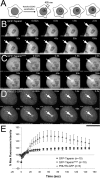Taperin (c9orf75), a mutated gene in nonsyndromic deafness, encodes a vertebrate specific, nuclear localized protein phosphatase one alpha (PP1α) docking protein
- PMID: 23213405
- PMCID: PMC3507197
- DOI: 10.1242/bio.2011049
Taperin (c9orf75), a mutated gene in nonsyndromic deafness, encodes a vertebrate specific, nuclear localized protein phosphatase one alpha (PP1α) docking protein
Abstract
The promiscuous activity of protein phosphatase one (PP1) is controlled in the cell by associated proteins termed regulatory or targeting subunits. Using biochemical and proteomic approaches we demonstrate that the autosomal recessive nonsyndromic hearing loss gene, taperin (C9orf75), encodes a protein that preferentially docks the alpha isoform of PP1. Taperin associates with PP1 through a classic 'RVxF' motif and suppresses the general phosphatase activity of the enzyme. The steady-state localization of taperin is predominantly nuclear, however we demonstrate here that the protein can shuttle between the nucleus and cytoplasm and that it is found complexed to PP1 in both of these cellular compartments. Although originally identified as a hearing loss gene, Western blot analyses with taperin-specific antibodies revealed that the protein is widely expressed across mammalian tissues as multiple splice variants. Taperin is a recent proteome addition appearing during the vertebrate lineage with the PP1 binding site embedded within the most conserved region of the protein. Taperin also shares an ancestral relationship with the cytosolic actin binding protein phostensin, another PP1 interacting partner. Quantitative Stable Isotope Labeling by Amino acids in Culture (SILAC)-based mass spectrometry was employed to uncover additional taperin binding partners, and revealed an interaction with the DNA damage response proteins Ku70, Ku80, PARP and topoisomerases I and IIα. Consistent with this, we demonstrate the active recruitment of taperin to sites of DNA damage. This makes taperin a new addition to the family of PP1 targeting subunits involved in the DNA damage repair pathway.
Keywords: DNA damage; Nonsyndromic deafness; Nucleus; Phostensin; Protein phosphatase one (PP1); Protein phosphorylation.
Figures







Similar articles
-
[Mutation screening in taperin gene in Chinese with prelingual nonsyndromic hearing impairment].Lin Chuang Er Bi Yan Hou Tou Jing Wai Ke Za Zhi. 2014 May;28(10):672-5. Lin Chuang Er Bi Yan Hou Tou Jing Wai Ke Za Zhi. 2014. PMID: 25129962 Chinese.
-
Importance of a surface hydrophobic pocket on protein phosphatase-1 catalytic subunit in recognizing cellular regulators.J Biol Chem. 2005 Apr 22;280(16):15903-11. doi: 10.1074/jbc.M500871200. Epub 2005 Feb 9. J Biol Chem. 2005. PMID: 15703180
-
Protein Phosphatase 1α Interacts with Venezuelan Equine Encephalitis Virus Capsid Protein and Regulates Viral Replication through Modulation of Capsid Phosphorylation.J Virol. 2018 Jul 17;92(15):e02068-17. doi: 10.1128/JVI.02068-17. Print 2018 Aug 1. J Virol. 2018. PMID: 29769351 Free PMC article.
-
Protein phosphatase 1 is a key player in nuclear events.Cell Signal. 2015 Dec;27(12):2589-98. doi: 10.1016/j.cellsig.2015.08.007. Epub 2015 Aug 11. Cell Signal. 2015. PMID: 26275498 Review.
-
Cracking the phosphatase code: docking interactions determine substrate specificity.Sci Signal. 2009 Dec 8;2(100):re9. doi: 10.1126/scisignal.2100re9. Sci Signal. 2009. PMID: 19996458 Review.
Cited by
-
Protein phosphatase 1γ isoforms linked interactions in the brain.J Mol Neurosci. 2013 May;50(1):179-97. doi: 10.1007/s12031-012-9902-6. Epub 2012 Oct 19. J Mol Neurosci. 2013. PMID: 23080069
-
CLIC5 stabilizes membrane-actin filament linkages at the base of hair cell stereocilia in a molecular complex with radixin, taperin, and myosin VI.Cytoskeleton (Hoboken). 2014 Jan;71(1):61-78. doi: 10.1002/cm.21159. Epub 2013 Dec 10. Cytoskeleton (Hoboken). 2014. PMID: 24285636 Free PMC article.
-
The reduced activity of PP-1α under redox stress condition is a consequence of GSH-mediated transient disulfide formation.Sci Rep. 2018 Dec 7;8(1):17711. doi: 10.1038/s41598-018-36267-6. Sci Rep. 2018. PMID: 30531830 Free PMC article.
-
Taperin bundles F-actin at stereocilia pivot points enabling optimal lifelong mechanosensitivity.J Cell Biol. 2025 Aug 4;224(8):e202408026. doi: 10.1083/jcb.202408026. Epub 2025 Jun 5. J Cell Biol. 2025. PMID: 40471101 Free PMC article.
-
Isolation of human mitotic protein phosphatase complexes: identification of a complex between protein phosphatase 1 and the RNA helicase Ddx21.PLoS One. 2012;7(6):e39510. doi: 10.1371/journal.pone.0039510. Epub 2012 Jun 28. PLoS One. 2012. PMID: 22761809 Free PMC article.
References
-
- Bespalova I. N., Van Camp G., Bom S. J., Brown D. J., Cryns K., DeWan A. T., Erson A. E., Flothmann K., Kunst H. P., Kurnool P. et al. (2001). Mutations in the Wolfram syndrome 1 gene (WFS1) are a common cause of low frequency sensorineural hearing loss. Hum. Mol. Genet. 10, 2501–2508 10.1093/hmg/10.22.2501 - DOI - PMC - PubMed
LinkOut - more resources
Full Text Sources
Molecular Biology Databases
Research Materials

